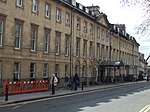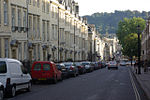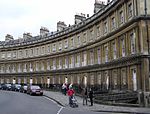Jane Austen Centre
Biographical museums in SomersetGrade II listed buildings in Bath, SomersetLiterary museums in EnglandMuseums in Bath, SomersetPlaces associated with Jane Austen ... and 2 more
Use British English from August 2015Women's museums in the United Kingdom

The Jane Austen Centre at 40 Gay Street in Bath, Somerset, England, is a permanent exhibition which tells the story of Jane Austen's Bath experience, and the effect that visiting and living in the city had on her and her writing. The building is part of a block (31–40 Gay Street) which has been designated by English Heritage as a Grade II listed building.Since 2001 it has hosted the annual Jane Austen Festival, the largest and longest running Jane Austen Festival in the world. Events include a Summer Ball and a costumed promenade through the centre of Bath. The Centre also has Regency Tea Rooms.
Excerpt from the Wikipedia article Jane Austen Centre (License: CC BY-SA 3.0, Authors, Images).Jane Austen Centre
Gay Street, Bath Kingsmead
Geographical coordinates (GPS) Address Phone number Website External links Nearby Places Show on map
Geographical coordinates (GPS)
| Latitude | Longitude |
|---|---|
| N 51.38404 ° | E -2.36316 ° |
Address
Jane Austen Centre
Gay Street 40
BA1 2NT Bath, Kingsmead
England, United Kingdom
Open on Google Maps











